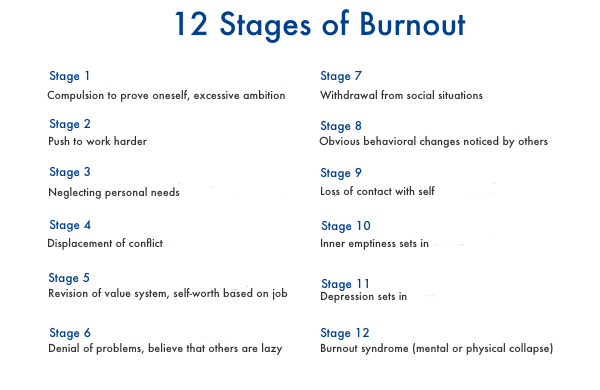3 Ways to Recover From Burnout


[contextly_auto_sidebar id="J1Mw6UhpXOvY0VunoSLbQTgoC7ifIiSE"]How can you recover from burnout once it's set in? This is one of the top questions I get from people new to the Ridiculously Efficient methodology of proactively scheduling your week to stave off burnout.
The following are my favorite methods.
1. Stop the Bleeding
Like dehydration, the moment you notice symptoms of burnout, you're already there. Check out this classic 12-stage progression of burnout from Herbert Freudenberger and Gail North, circa the 70s:

If you see yourself above in anything past, say, Stage 3, it's time to get serious about fighting burnout, fast.
Start with sleep. By hook or by crook, get a full night's rest.
Next, move to downtime. What can you do to get some consecutive days off? Failing that, how can you carve out fully unplugged evenings and pieces of your morning?
Think of the above practices -- sleep, consecutive days off, and fully unplugged evenings and mornings -- as a tourniquet to stop the bleeding.
Do nothing else on this list until you can at least say you're well-rested and have some guaranteed opportunities to recharge and reset.
2. Satisficing
"Satisficing," a portmanteau of "satisfying" and "sufficing," forces you to relax your perfectionist tendencies. Identified in a joint study published in the Journal of Personality and Social Psychology, so-called "maximizers" can feel more perfectionism, regret and even depression if the options available to them increase.
To fight this, psychologist Melody Wilding recommends we look for the most feasible solution, versus the optimal solution. This is a learned skill for achievers who are accustomed to cranking out high-quality work, but it's truly what influences your feelings about work.
Satisficing is a part of my DNA, so deeply ingrained that I didn't think twice about how this approach might be novel. I wrote about my emotional detachment to writing content, which has helped me publish over 10,000 articles (which got over 40 million views) in the past few years.
This ability also helps me in my work as a project manager for an industry-transforming entrepreneur.
When the vision I'm given to execute is big, bold and unlike anything I've ever done before, as it often is, satisficing is the only way to transition from idea to live project. It's sometimes physically impossible to execute the vision as expressed -- some level of mediation between the ideal and the real is required.
3. Fire Up the Power Plant
Think about yourself as a power plant -- a source of vital energy. Now think about the activities you engage in and the people you interact with throughout the day.
For each, ask yourself this: Is this person/activity giving me energy or taking it away?
Look for patterns, and use them to adjust your behavior and interactions.
In some cases, it's an easy swap: don't eat a heavy lunch on a busy workday.
In others, it isn't as easy.
What if every interaction with your boss takes vital energy away?
You can't stop talking to your boss... but you can start to add in activities that give you energy after a particularly stressful interaction.
Conclusion
In the spirit of satisficing, recognize that nothing will ever be perfect.
That fact doesn't mean that all efforts to improve your work-life scenario are futile. Even the tiniest changes to your routine can have dramatic effects on your health, well-being and performance at work.
If you want my help with this, consider applying for a slot in my Ridiculously Efficient coaching program.
Subscribe for Insider Wisdom
Get fresh takes on work-life alignment, leadership, and optimizing quality of life.


Member discussion